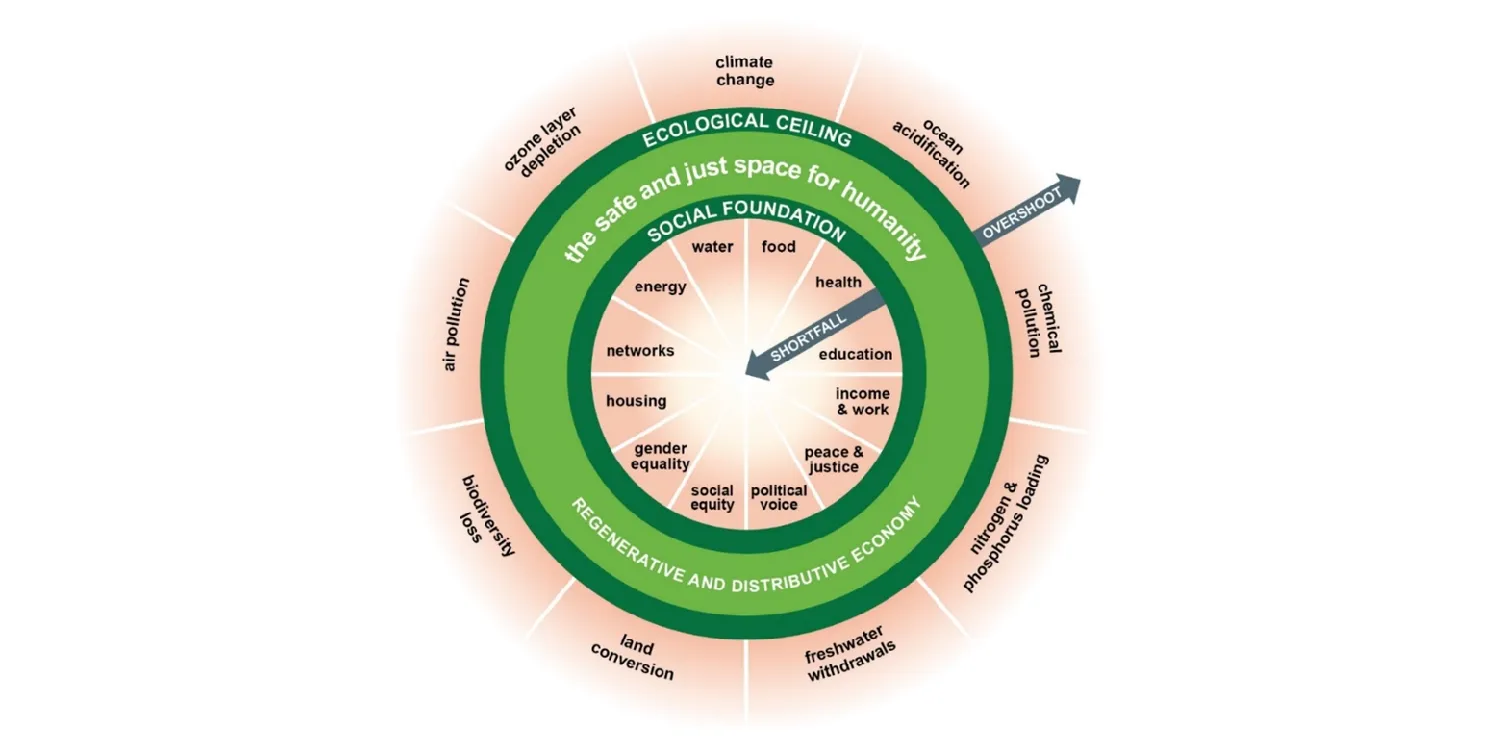Doughnut Economics for 21st Century Challenges

Illustration by Irhan Prabasukma.
Since the dawn of the first industrial revolution, growth has been the motto of the global economy. Many economists believed that focusing on growth alone would lift people and societies out of poverty, and everyone would thrive as a result. While it is true that the global economy has grown spectacularly, not everything turned out the way they predicted. Then, can the Doughnut Economics framework help tackle 21st-century issues?
The Doughnut Economics
Take income inequality. In 2021, the top 10% of the world’s population took home 52% of the total global income, while the poorest half took home just eight percent. Moreover, the growth-focused economy, which relies on 19th and 20th-century economic theories and assumptions, has also led to major environmental problems. Today, climate-related catastrophes happen three times more often than in the 1970s and 1980s. So, what we need is a 21st century economic mindset to address our 21st century problems.
In 2012, economist Kate Raworth took a decisive step in that direction by introducing the Doughnut Economics, a visual framework for sustainable development. Like the name, the framework can be illustrated with a doughnut shape, consisting of two concentric circles.

The inner circle represents the social foundation, which contains the social aspects mentioned in the UN’s Sustainable Development Goals. It represents a space where people have complete access to basic necessities such as clean air, food, water and sanitation, housing and energy, education, social equity, and gender equality. People who lack access to these aspects will fall below the social foundation into the doughnut hole.
Meanwhile, the outer circle represents the ecological ceiling. It refers to our planet’s nine environmental boundaries which were put forward by earth system scientists, Johan Rockström and Will Steffen. Overshooting these boundaries can destabilize the planet and cause irreversible damage to people and the environment. To avoid such social and environmental destabilization, the Doughnut recommends that we stay in the space between the social foundation and the ecological ceiling, where humanity has access to necessities without exceeding environmental limits.
In the 21st century, many people are in the doughnut hole. For example, according to the 2024 global report on food crises, 282 million people suffer from acute hunger because of conflicts, climate change, and economic crises. At the same time, we have already exceeded at least four of the nine planetary boundaries (climate change, biodiversity loss, land conversion, and nitrogen & phosphorus pollution). This indicates that the growth-only focused economy backed up by 19th and 20th-century economic theories and assumptions has its limitations.
Limitations of Traditional Economic Assumptions
Let’s examine these assumptions a bit more closely. In his book The Wealth of Nations, Adam Smith introduced the “self-interest” assumption, which states that production and consumption based on self-interest can ultimately fulfill everyone’s needs. In other words, by selling, buying, and consuming for your own self-interest, everyone ultimately wins.
However, Adam Smith might have failed to consider mega-corporations. Take oil companies for example. Since the 1970s, oil companies have been informed of the negative impacts of fossil fuels on the environment. Between 1970 and 2011, fossil fuels and industrial processes were responsible for increasing greenhouse gas emissions by 78%, leading directly to climate change-related disasters.
Despite the impacts, these companies make only minimal efforts to mitigate the environmental damages, often in the name of profits. This illustrates how operating from a place of self-interest often only results in fulfillment for a select few while others bear the cost.
Another popular traditional economic assumption is that “man is rational”. It assumes that people make decisions based on perfect information and careful calculation of cost and benefits. But does this reflect reality?
For instance, people with gambling addiction often take irrational risks to continue gambling for the chance to win, such as by incurring debts or jeopardizing their health and social life. This kind of irrational decision-making happens not only in the casino but also in everyday economic activities.
Moreover, there is also the assumption about the circular flow of income. On a broader scale, 20th-century economics assumes that economic activities only occur between households and firms. Households provide labor to firms and receive wages in return. The wages are then used to buy goods and services from firms, creating a cycle known as the circular flow of income.
However, this circular flow of income does not paint the complete picture of the economy. Using this incomplete picture, economists have created the GDP (Gross Domestic Product) metric. GDP tells us about aggregate consumption, but not the wellbeing of consumers. It recognizes household spending but not contributions made by a homemaker. It informs us about production but not pollution. It includes government expenditure and private investments but not the outcomes generated from them. It only acknowledges the value of trees when cut down and turned into benches but not the value they provide when left standing.
Keeping People and the Planet in the Doughnut
Now that we know the limitations of these 19th and 20th-century assumptions, how does the Doughnut Economics framework help us overcome these shortcomings? First, considering how the self-interest of disproportionately powerful mega corporations impacts society and the environment, governments must implement strict regulations and other levers to prevent them from harming people and the planet.
Second, humans do make irrational decisions, so policies need to account for that. Policymakers must introduce regulations to restrict or de-incentivize damaging behaviors. Additionally, they should craft and implement policies that tackle the root of the issues and support people to shift towards more positive behaviors.
Third, development needs to be redefined to match our 21st-century needs. Sustainable growth must be regenerative. It must focus on reducing, reusing, refurbishing, and recycling the resources in our economies. Furthermore, growth also needs to be distributed. Resources like land, money, knowledge, and technology must be equitably shared among people.
Whether the Doughnut Economics framework is the key to solving our 21st century problems remains to be seen. Still, it demonstrates how the traditional approach of constant growth based on 19th century assumptions is clearly not working. The Doughnut suggests a more balanced and wider view of economics; an approach that tries to include all aspects of the economy and rejects the idea that “more is better”. Ultimately, governments, businesses, and civil society must work together to bring everyone within the safe, just, and inclusive space of the doughnut.
Editor: Nazalea Kusuma & Kresentia Madina

Join Green Network Asia Membership
If you find this content useful, support Green Network Asia’s movement to create positive impact for people and the planet through public education and multi-stakeholder advocacy on sustainability-related issues and sustainable development. Get exclusive benefits for your personal and professional development.
Become a Member Now
Nurul Ardhaninggar
Nurul is a master’s degree student at International Relations, Universitas Gadjah Mada, with a focus on digital transformation and competitiveness.


 Understanding and Addressing Multiple Dimensions of Child Deprivation
Understanding and Addressing Multiple Dimensions of Child Deprivation  Building Heat Resilience Amidst Rising Risk in the Asia-Pacific
Building Heat Resilience Amidst Rising Risk in the Asia-Pacific  Sounds Right and Recognizing Nature as an Artist for Biodiversity Conservation
Sounds Right and Recognizing Nature as an Artist for Biodiversity Conservation  Statewide Treaty Bill: Australia’s First Treaty with the Indigenous Australians Passed in Victoria
Statewide Treaty Bill: Australia’s First Treaty with the Indigenous Australians Passed in Victoria  Involving Coastal Communities in Tackling Ghost Nets Pollution
Involving Coastal Communities in Tackling Ghost Nets Pollution  An Interview with Jasmin Lim, Chief Marketing Officer at BH Global
An Interview with Jasmin Lim, Chief Marketing Officer at BH Global